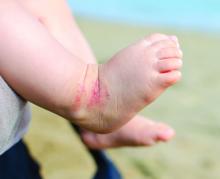SAN DIEGO — Whether you completed your dermatology residency training 20 years ago or 2 years ago, recent advances in treatments for atopic dermatitis (AD) have likely influenced your “go to” interventions when treating children with AD, according to Lawrence F. Eichenfield, MD.
“There have been many changes in the understanding of AD and recognition of the variable courses of the disease, and the associated allergic and nonallergic comorbidities,” Dr. Eichenfield, chief of pediatric and adolescent dermatology at Rady Children’s Hospital-San Diego in California, said at the Society for Pediatric Dermatology meeting, held the day before the annual meeting of the American Academy of Dermatology. “With our revolutionary systemic and evolving topical therapies, we are in a new day of pediatric management.”
Drawing from 2023 American Academy of Dermatology guidelines of care on topical treatments of AD and his own clinical experience, he shared his perspective on “what’s tried and true” in care for patients with persistent eczema:
Both bathing and moisturizing leave skin moist. It’s well established that the use of moisturizers/emollients minimizes xerosis and the amount of prescription anti-inflammatory medications, but limited evidence exists to recommend a particular ingredient and formulation, said Dr. Eichenfield, also professor of dermatology and pediatrics at the University of California, San Diego. “Future studies may tell us whether specific moisturizers work better than others, and/or if early interventions may prevent AD, but that remains a big question mark,” he noted. In addition, applications may sometimes “mobilize” topical prescriptive residual absorption and activity.
As for baths, he said, “avoidance of bathing to avoid drying out skin is a practice without evidence basis. Bathing also may have many benefits in active eczema.”
Bleach baths may enhance skin barrier function, reduce itch, and improve eczema, but the practice remains controversial, he continued. Authors of a systematic review and meta-analysis concluded that while bleach baths are effective in reducing the severity of AD, they do not appear to be more effective than water bath alone. Authors of a more recent study found that bleach baths did not normalize dysbiosis, “but that study did not compare outcomes to bathing without bleach,” Dr. Eichenfield noted.“My sense is there is some benefit to regular bathing, especially in children with moderate to severe AD, especially those with colonized or infected eczema.”
He advises clinicians to be aware of other “standard AD interventions” from around the world, including black tea wet dressings and green tea bath therapy.
Topical corticosteroids. These are “tried and true” for their anti-inflammatory properties and rapid response, relatively low cost, and large range of potency, he said. Potential problems include the burden of topical application and the potential for stinging/burning, atrophy, telangiectasias, adrenal axis suppression, and concerns about withdrawal phenomena. “Being a proponent of topical corticosteroids, but explaining reasonable and appropriate use can be challenging,” Dr. Eichenfield said. “Social media has influenced concerns about topical corticosteroids, with steroid addiction and withdrawal being concerns influencing discomfort with therapies.”



